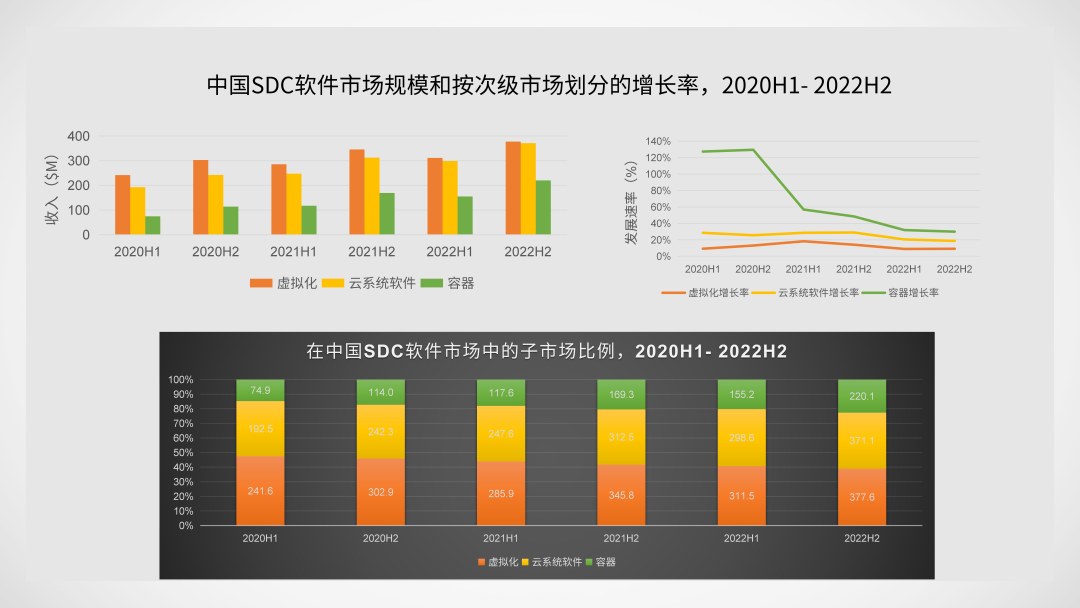The main text contains 2604 words, with an estimated reading time of 8 minutes.
The pandemic has changed the global business landscape, making scalability and growth objectives crucial parts of enterprise development plans, particularly for data centers.
In the model of software-defined data centers, virtualization technology plays one of the most central roles, abstracting physical resources into capabilities such as computing, storage, and networking through software. Undoubtedly, over the past 20 years, virtualization solutions represented by VMware have achieved tremendous success, with all Fortune 100 companies adopting VMware’s virtualization solutions.
After reading our series of articles, some readers may think:
The best application scenario for virtualization technology is only in small data centers, which can serve as a model of being small and beautiful, but it struggles in the face of medium to large data centers.
Is this the truth?
Virtualization is advancing, and technical issues are not a bottleneck.
There are no eternal kings in the world. With the emergence of new technologies such as big data, AI, and blockchain, coupled with the significant siphoning effect of public clouds on small and medium enterprises, virtualization, once highly regarded as a “sweet spot,” has now become “a burden.” Compared to full-stack cloud platforms with thousands of nodes, is virtualization really outdated?
The core of data center virtualization mainly includes computing (server) virtualization, storage virtualization, and network virtualization. The scale supported by computing and storage virtualization depends on factors such as software capabilities and business considerations. From the perspective of software capabilities, achieving support for tens of thousands of nodes simultaneously is not difficult; it can be achieved through distributed multi-layer scheduling architectures and multi-region scheduling designs to achieve ideal results. The constraints such as cluster quantity control or access conditions are mainly considered for the independence and broad compatibility of the software layer, as well as its adaptability to complex environments, whether for ultra-large-scale deployments, medium to large virtual data centers, or even single-node deployments. Unlike full-stack cloud platforms that are inherently designed for distributed architecture applications, virtualization provides continuity and reliability protection that is more fully considered for various applications (including monolithic architecture, three-tier architecture, SOA architecture, etc.).
The evolution of virtualization technology is still ongoing and is advancing to another mature level, including but not limited to: enhancements in RAS (Reliability, Availability, and Serviceability) protection, PB-level memory pools, integration and collaboration of DPUs, support for new models such as privacy computing, and governance of LLMs. These new evolutionary directions will lead to new demand trends and will complement other digital solutions based on virtualization.
Storage virtualization technology represented by distributed storage has significant advantages such as linear scalability, multi-replica protection, and cross-data center capabilities, serving as the default storage resource provider for full-stack cloud platforms.
As for network virtualization, after solving the mapping and simulation from logical networks to physical networks, the currently hot topic of SDN is designed for medium to large data centers and cross-data center large-scale Layer 2 network connectivity, gradually maturing to solve the consistency issues of large-scale network scheduling strategies for virtual machines.
As can be seen, virtualization can easily handle different scales of data centers, whether large, medium, or small, but in the process of commercial implementation, it often needs to weigh technology and market models. Various cloud operating systems and solutions, after the “beautification” of digital transformation, can advance rapidly, but behind this, there is the low-profile contribution of virtualization.
“Not recognizing the true face of Mount Lu,” virtualization has deeply cultivated medium to large data centers.
In fact, virtualization is ubiquitous. The vertical fields where virtualization performs most actively includegovernment, telecommunications, education, media, manufacturing, etc. The segmented application development (such as new media, video processing, facial recognition, etc.) has led to massive data accumulation, driving the growth of the virtualization market.

Today’s enterprises rely on data operations and business strategy formulation, and the continuous growth of data drives IT infrastructure to support data processing quickly and effectively. Large-scale cloud computing data centers based on virtualization further refine the allocation of abstract computing resource pools at a certain granularity, transparently providing users with supercomputing capabilities based on virtualization resources for scheduling, supply, and measurement, reaching a scale of tens of thousands of physical servers is particularly normal; as hardware performance continues to improve, the virtualization ratio has long surpassed 20:1 and 50:1, and running hundreds of thousands of virtual machines is entirely foreseeable. Taking Google’s 36 data centers worldwide as an example, they support over 300,000 physical servers using virtualization, SDN network architecture innovation, renewable energy, and other technologies.
According to the latest forecast from Global Market Insights, the data center virtualization market is expected to expand at a CAGR of over 20% to reach $20 billion by 2030, with government initiatives promoting public data digitization and significant investments by large companies in cloud and data being the main drivers of the industry.
As the demand for data services gradually exceeds the basic scope of virtualization, users will seek digital service solutions based on virtualization in the form of cloud operating systems or cloud solutions. However, cloud operating systems (such as OpenStack) do not possess virtualization capabilities themselves and still require virtualization as the supporting foundation for workloads. Therefore, whether in public clouds or private clouds, they are essentially data centers based on virtualization.
From the perspective of ecological integrity, infrastructure integration, and security capabilities, virtualization holds a better hand.
Despite having obtained the ticket to the data center early on and having matured through the rigorous testing of complex environments and application architectures, virtualization still faces challenges from many emerging technologies. Among them, the most threatening is cloud-native container technology. Compared to traditional virtual machines, containers have faster startup times and lower resource consumption, and the containerization of large data centers can achieve more advantageous computing density, elasticity, and DevOps support.
From the above perspective, container solutions indeed have unparalleled appeal, but if we broaden the perspective and extend the timeline, it may not be the case; virtualization, the older brother, has stronger cards to play.
In terms of ecological integrity, virtualization not only achieves the adaptation layer between the operating system and hardware but also cannot be simply judged in terms of software compatibility and horizontal interoperability. So far, container engines still have strict limitations and requirements on the operating system kernel, while virtualization’s support and collaboration are much broader. Additionally, PaaS platforms built on containers are often bound to vendor-built ecosystems, making it less easy to migrate applications using PaaS technology compared to IaaS platforms.
In terms of infrastructure integration, virtualization involves much more than containers; in addition to servers (which containers mainly rely on the operating system for compatibility), it must also ensure seamless compatibility with various storage protocols or devices, network protocols, and devices. Conversely, device manufacturers are more inclined to provide more mature support and recognition for virtualization.
For infrastructure operations personnel, mastering virtualization is crucial. In terms of security, the isolation and security of containers are far inferior to virtualization, with a larger attack surface making protection more difficult. The development of container security technology lags behind the development of containers and cloud-native businesses. In recent years, high-profile security incidents have primarily targeted containers, and the development of secure container technology is still in its early stages, requiring a long way to go before commercialization.
In a multi-cloud architecture, virtualization cannot be absent.
More and more enterprises realize that adopting a single cloud computing provider inevitably leads to a series of issues such as device or ecosystem binding, inefficient competition, and data ownership. Thus, multi-cloud architecture has become a trend among leading or mid-tier users that is not entirely driven by technology. Multi-cloud management may include public clouds, private clouds, virtualization resource pools, and diverse devices, achieving governance and cost optimization of heterogeneous resources through multi-cloud management platforms.

In the trend of multi-cloud architecture, virtualization is a strategy to maintain competitiveness and optimal investment. It is essential to understand that virtualization is the root technology of cloud data centers. Regardless of whether multi-cloud is introduced, virtualization investment in data centers is indispensable; the investment in public clouds or large private cloud platforms involves considerations beyond vendor capabilities, product technology, service support, and business, including the user’s organizational structure, medium to long-term business planning, data storage, and utilization, among various complex issues.
Virtualization does not face the risks of insufficient or excessive planning. Even based on virtualization, significant research accumulation and innovative development can be achieved, making it the most reliable option among many routes. Additionally, in terms of multi-cloud management, even if multi-cloud management platforms continuously update their code, it is challenging to keep up with the iterations of cloud vendors because, apart from the IaaS layer, it is difficult to unify APIs and models at higher service levels. Therefore, the standardization and openness of virtualization are prioritized for combining automation with multi-cloud and other tools to achieve cloud management goals more quickly.
The above is my understanding of virtualization in data centers. In summary: virtualization does not face issues in addressing medium to large data centers, having achieved successful implementation in multiple industries; in the face of challenges from new technologies and the multi-cloud trend, virtualization remains a preferred option for users.
More Information
1. Containers or virtualization? You don’t need to be technically anxious.
2. The “love” and “hate” of financial institutions towards distributed storage.
3. Financial institutions do not take a step back; this is the right approach!
4. Understanding | The construction of enterprise-level virtualization platforms for financial institutions under the trend of heterogeneous computing.
5. “The battle” is imminent when “containers” meet “virtualization”.

Learn more about virtualization news
Call our customer service hotline
400-6300-003

Scan to get the cloud product manual
– END –
 Scan to follow us
Scan to follow us
More product releases, channel sharing, industry strategies
Sharing and discussing with everyone
